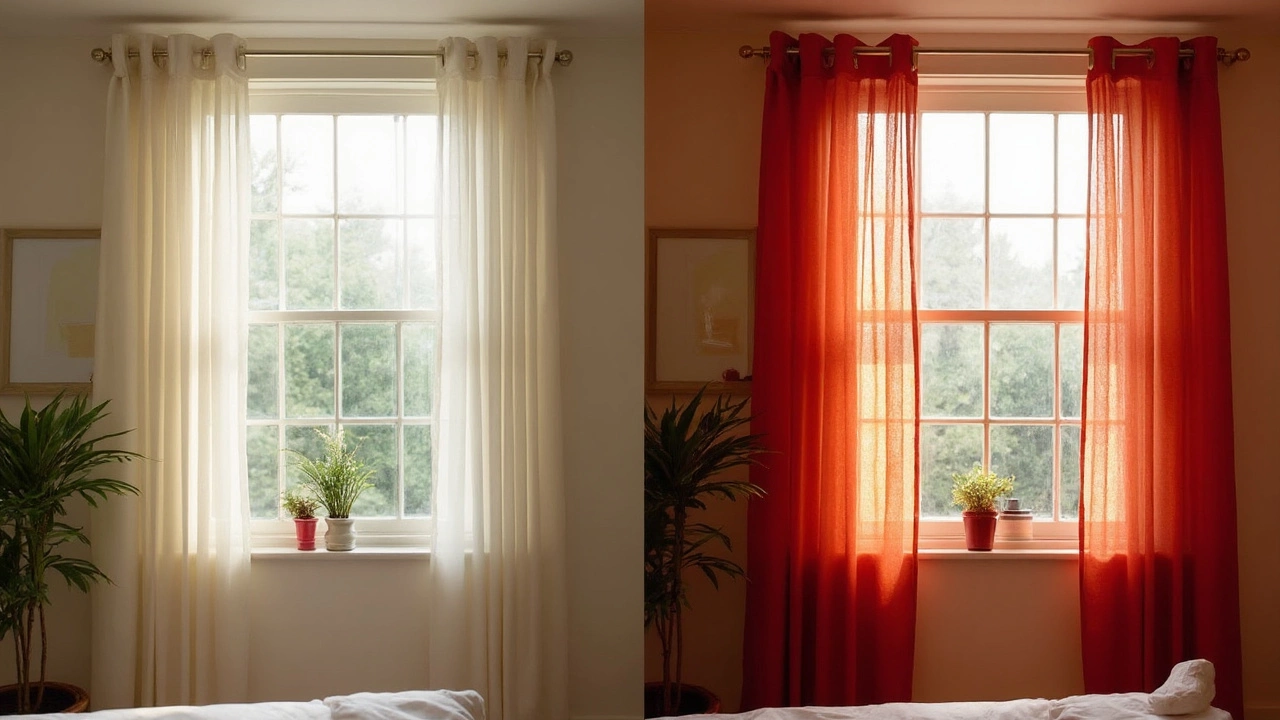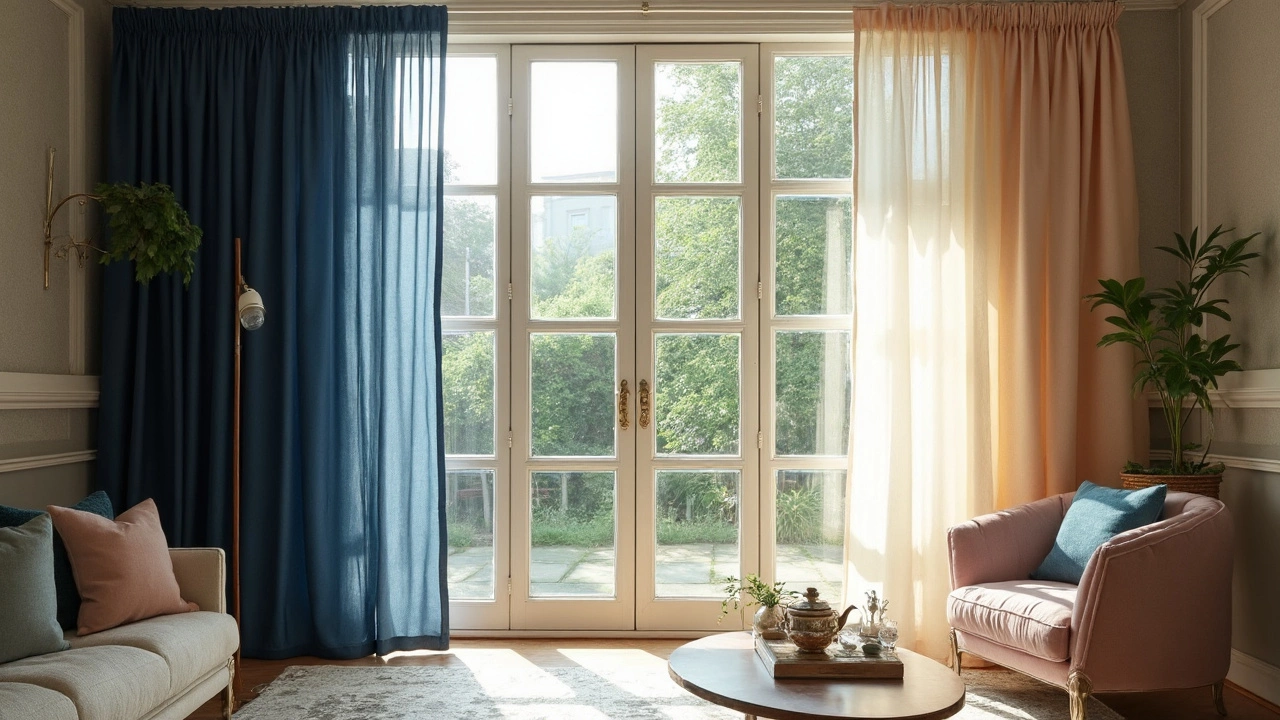Ever woken up way too early because the sun blasted through your curtains? The struggle is real. Not all curtains do an equal job, and the color you pick seriously impacts how much sunlight makes it into your space. If you're tired of squinting at your breakfast table or if your room heats up faster than your coffee, it's time to rethink your curtain choices.
Here’s something you might not expect: dark-colored curtains, especially deep blacks or navy blues, do the best job at blocking sunlight. Light colors like white, cream, or pale yellow tend to let more light squeeze through. So if the goal is a pitch-black room or keeping things cool in summer, you’ll want to go dark. But there's more to the story than color alone — fabric and lining can flip the script entirely. Let’s dig into what actually works and how you can make your (next) curtain pick a smart one.
- Why Curtain Color Matters for Sunlight Blockage
- Blackout vs. Regular Curtains: What's the Real Difference?
- Comparing Popular Curtain Colors for Light Blocking
- Types of Fabric and Lining: Do They Help?
- Smart Shopping Tips for Sun-Blocking Curtains
Why Curtain Color Matters for Sunlight Blockage
Color might seem like just a style choice, but when it comes to curtains, it actually affects how much sunlight gets through. Dark colors like black, charcoal, and navy absorb a lot of light. This means less sunlight sneaks into your room, making things dimmer and cooler. On the flip side, light colors like white, beige, or pastel shades reflect sunlight. They don’t stop as much light, so your room will stay brighter—and probably warmer, too.
Why does this happen? Here’s the science in plain language: colors that are darker soak up more of the sun’s rays, turning that energy into a bit of heat but mostly blocking it from passing through. Light colors just bounce the light around, which is great for rooms where you want more daylight, but not ideal if you’re trying to block out the sun for sleep or to keep things comfortable in hot weather.
Here’s a quick breakdown of how popular curtain colors rank against sunlight:
| Curtain Color | Sunlight Blockage |
|---|---|
| Black | Excellent |
| Navy Blue | Very Good |
| Dark Grey | Good |
| Beige/White | Poor |
If your biggest pet peeve is sunlight waking you up or turning your living room into a greenhouse, skip the lighter options. Go for recognized sun-blockers like black or dark blue curtains. That said, color isn’t the only factor—fabric and added linings can really boost how well your curtains handle strong sunlight. Still, color is the first thing to check when you want your space darker and cooler.
Blackout vs. Regular Curtains: What's the Real Difference?
If you’re comparing blackout curtains to regular ones, the gap is huge. Blackout curtains aren’t just a little better at blocking light—they’re designed to keep almost all sunlight out, period. Most regular curtains just dim the room or give you privacy, but sunshine will sneak through, especially with lighter curtain colors.
The secret is in the layers. Blackout curtains have a special coating or an extra lining, usually made of dense fabrics like polyester or triple-weave cloth. Some even mix in foam. This blocks up to 99% of sunlight, not just dimming the glow but stopping it in its tracks. Regular curtains, on the other hand, are usually just one or two layers of thinner, lighter fabric. They might look good, but can’t fight off that bright sunlight.
If you care about temperature, this next bit matters: blackout curtains help keep rooms cool by stopping the sun’s heat. You’ll notice they can cut down your need for blasting the AC in summer. And if you live somewhere hot, that means savings. A 2022 industry survey found rooms with true blackout curtains stayed up to 12°F (about 6.7°C) cooler on hot afternoons versus those with just regular curtains. That’s real comfort you can feel.
| Feature | Blackout Curtains | Regular Curtains |
|---|---|---|
| Blocks sunlight (%) | 85-99% | 20-60% |
| Energy savings | High | Low to moderate |
| Best for privacy | Excellent | Moderate |
So if you need a dark bedroom for sleeping in, a cooler living room, or home theater vibes, blackout curtains are a game changer. They cost a bit more, but the comfort and energy savings are worth it. Regular curtains work if you just want something stylish or need a little privacy, but don’t expect them to tackle strong sunlight or stop heat quite like blackouts do.

Comparing Popular Curtain Colors for Light Blocking
Not all curtain colors do the same thing when it comes to fighting off sunlight. If you’re aiming to block out the sun, curtains with darker colors are your best friend. Black, navy blue, charcoal grey, and deep burgundy stand out as the top picks for downright blocking the most sunlight. These colors soak up light instead of letting it bounce through the fabric. That means less glare, less heat, and zero rude early morning sunbeams.
Lighter colors—think white, cream, pale pink, or light blue—just can’t compete. They’re alright for a soft, airy look, but don’t expect them to keep your room dark or cool. White and cream especially let lots of light in, so you’ll basically have to double up with extra thick fabrics or blackout linings to get any serious shade.
Here’s a quick look at how different popular curtain colors stack up when it comes to blocking light:
| Color | Light Blocking Ability |
|---|---|
| Black | Excellent |
| Navy Blue | Very Good |
| Dark Grey | Very Good |
| Burgundy | Good |
| Medium Brown | Average |
| Beige | Fair |
| White | Poor |
Textile expert Laura Nelson from the National Sleep Foundation points out,
“Dark colors do a much better job than lights at keeping sunlight out, but for true blackout, it’s all about adding a proper lining.”
If you care mostly about blocking heat, dark curtains will help because they stop most UV rays. But if your window really bakes in the afternoon, pair those dark shades with a UV protection or blackout lining. You don’t have to go 100% black—any deep color usually beats pastels or whites for sunlight control. In the end, your curtain choice is all about the right mix of look and actual blocking power.
Types of Fabric and Lining: Do They Help?
If you think curtain color is the only thing that matters, think again. The type of fabric—and whether that curtain has a lining—can make or break how well it stops the sun. Some materials act like a brick wall against sunlight, while others are more like a leaky sieve.
Let’s break down the heavy hitters:
- Blackout curtains use thick, tightly woven fabric (often polyester or a blend), usually with an extra layer or foam backing. These block up to 99% of sunlight and are a top choice for bedrooms, nurseries, or anyone needing total darkness.
- Thermal curtains almost always have a special lining—sometimes even two. This helps block light and keeps heat out (or in, depending on the season). Great for saving on your energy bill too.
- Regular cotton or linen curtains, even in dark colors, still let a surprising amount of sunlight slip through. Without a special lining, they just don’t cut it if you want a really dark room.
What about linings? Honestly, adding a curtain lining is a game changer if you've already got curtains you like. There are simple white linings that help dim sunlight a bit or blackout liners that can take regular curtains to the next level. These snap or hook onto most curtain panels—no need to start from scratch.
Here’s a quick look at how different curtains compare for blocking sunlight, based on real-world measurements:
| Type | % Sunlight Blocked |
|---|---|
| Blackout curtains with lining | 95-99% |
| Thermal curtains with lining | 85-98% |
| Regular heavy fabric (dark color) | 60-75% |
| Lightweight fabric (any color) | 20-40% |
The numbers say it all. If you want to seriously block sunlight, don’t just focus on color—go for specialty fabrics and always check for a lining. You’ll sleep better, cut your cooling costs, and skip the daily game of dodging sunbeams in your living room.

Smart Shopping Tips for Sun-Blocking Curtains
Picking sun-blocking curtains is about more than just liking the way they look. If you want to truly keep sunlight out and protect your home from heat and fading, you have to pay attention to how they're made, what color you choose, and the features they offer.
- Go for blackout material if you want serious results. Blackout curtains are designed with special layers that block up to 99% of sunlight. Not every dark curtain does the job—look for the "blackout" label.
- Choose dark, dense fabrics. If style counts, pick deep colors like black, navy, or charcoal in a thick fabric. These work better than pale colors and thin materials for keeping light out.
- Check the lining. A good curtain liner can double the sun-blocking effect, even if the curtain itself isn't super dark. Some brands add a white foam layer or thermal backing—those boost your defense against heat and fritter away less light.
- Mind the measurements. Curtains should overlap your window edges by a few inches on all sides. If they don’t, light slips in around the gaps. Floor-length and ceiling-height curtains are best for keeping rooms dim.
- Think about bonus features. Curtains with UV protection don’t just keep rooms cooler—they help stop furniture and floors from fading, too. Some brands even add noise-reducing layers for extra comfort.
Curious about how blackout and regular curtains stack up? Here’s a quick comparison:
| Type | Light Blocked (%) | Best Color |
|---|---|---|
| Regular Curtain | 30-50 | Dark shades |
| Blackout Curtain | 85-99 | Any (lining does the work) |
Not sure where to start? Choose blackout curtains if you need a sleep cave, or pick a thick, dark fabric with a liner for living spaces that need less light but don’t need total darkness. Remember, whatever you choose, proper fitting and installation make just as much difference as the fabric and color.

